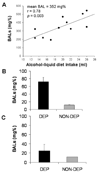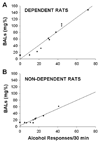Operant behavior and alcohol levels in blood and brain of alcohol-dependent rats
- PMID: 19740131
- PMCID: PMC2789881
- DOI: 10.1111/j.1530-0277.2009.01051.x
Operant behavior and alcohol levels in blood and brain of alcohol-dependent rats
Erratum in
- Alcohol Clin Exp Res. 2010 Feb;34(2):382
Abstract
Background: The purpose of the present investigation was to more clearly define blood-alcohol parameters associated with alcohol dependence produced by alcohol vapor inhalation and alcohol-containing liquid diet.
Methods: Alcohol levels in blood and brain were compared during and after 4 hours of acute alcohol vapor exposure; also, brain-alcohol levels were assessed in alcohol-exposed (14-day alcohol vapor) and alcohol-naïve rats during and after 4 hours of acute alcohol vapor exposure. A separate group of rats were implanted with i.v. catheters, made dependent on alcohol via vapor inhalation, and tested for operant alcohol responding; blood-alcohol levels (BALs) were measured throughout operant alcohol drinking sessions during alcohol withdrawal. A final group of rats consumed an alcohol-liquid diet until they were dependent, and those rats were then tested for operant behavior at various withdrawal time points; BALs were measured at different withdrawal time points and after operant sessions.
Results: Blood- and brain-alcohol levels responded similarly to vapor, but brain-alcohol levels peaked at a higher point and more slowly returned to zero in alcohol-naïve rats relative to alcohol-exposed rats. Alcohol vapor exposure also produced an upward shift in subsequent operant alcohol responding and resultant BALs. Rats consumed large quantities of alcohol-liquid diet, most of it during the dark cycle, sufficient to produce high blood-alcohol levels and elevated operant alcohol responding when tested during withdrawal from liquid diet.
Conclusions: These results emphasize that the key determinants of excessive alcohol drinking behavior are the BAL range and pattern of chronic high-dose alcohol exposure.
Figures






Similar articles
-
The gamma-aminobutyric acid-B receptor agonist baclofen attenuates responding for ethanol in ethanol-dependent rats.Alcohol Clin Exp Res. 2007 Jan;31(1):11-8. doi: 10.1111/j.1530-0277.2006.00259.x. Alcohol Clin Exp Res. 2007. PMID: 17207096 Free PMC article.
-
Effects of β-adrenoceptor antagonists on alcohol drinking by alcohol-dependent rats.Psychopharmacology (Berl). 2010 Oct;212(3):431-9. doi: 10.1007/s00213-010-1967-8. Epub 2010 Jul 31. Psychopharmacology (Berl). 2010. PMID: 20676608 Free PMC article.
-
Dissociating Motivational From Physiological Withdrawal in Alcohol Dependence: Role of Central Amygdala κ-Opioid Receptors.Neuropsychopharmacology. 2016 Jan;41(2):560-7. doi: 10.1038/npp.2015.183. Epub 2015 Jun 24. Neuropsychopharmacology. 2016. PMID: 26105136 Free PMC article.
-
Operant alcohol self-administration in dependent rats: focus on the vapor model.Alcohol. 2014 May;48(3):277-86. doi: 10.1016/j.alcohol.2013.08.006. Epub 2013 Nov 1. Alcohol. 2014. PMID: 24290310 Free PMC article. Review.
-
Operant ethanol self-administration in ethanol dependent mice.Alcohol. 2014 May;48(3):295-9. doi: 10.1016/j.alcohol.2014.02.002. Epub 2014 Mar 13. Alcohol. 2014. PMID: 24721194 Free PMC article. Review.
Cited by
-
Effects of alcohol dependence and withdrawal on stress responsiveness and alcohol consumption.Alcohol Res. 2012;34(4):448-58. Alcohol Res. 2012. PMID: 23584111 Free PMC article. Review.
-
Inhibition of the rostromedial tegmental nucleus reverses alcohol withdrawal-induced anxiety-like behavior.Neuropsychopharmacology. 2019 Oct;44(11):1896-1905. doi: 10.1038/s41386-019-0406-8. Epub 2019 May 6. Neuropsychopharmacology. 2019. PMID: 31060041 Free PMC article.
-
Alcohol, stress hormones, and the prefrontal cortex: a proposed pathway to the dark side of addiction.Neuroscience. 2014 Sep 26;277:139-51. doi: 10.1016/j.neuroscience.2014.06.053. Epub 2014 Jul 3. Neuroscience. 2014. PMID: 24998895 Free PMC article. Review.
-
Protection against alcohol-induced neuronal and cognitive damage by the PPARγ receptor agonist pioglitazone.Brain Behav Immun. 2017 Aug;64:320-329. doi: 10.1016/j.bbi.2017.02.001. Epub 2017 Feb 3. Brain Behav Immun. 2017. PMID: 28167117 Free PMC article.
-
Glucocorticoid receptor modulators decrease alcohol self-administration in male rats.Neuropharmacology. 2021 May 1;188:108510. doi: 10.1016/j.neuropharm.2021.108510. Epub 2021 Feb 26. Neuropharmacology. 2021. PMID: 33647278 Free PMC article.
References
-
- Addolorato G, Caputo F, Capristo E, Domenicali M, Bernardi M, Janiri L, et al. Baclofen efficacy in reducing alcohol craving and intake: a preliminary double-blind randomized controlled study. Alcohol Alcohol. 2002;37:504–508. - PubMed
-
- Becker HC, Hale RL. Repeated episodes of ethanol withdrawal potentiate the severity of subsequent withdrawal seizures: an animal model of alcohol withdrawal “kindling”. Alcohol Clin Exp Res. 1993;17:94–98. - PubMed
-
- Cagetti E, Baicy KJ, Olsen RW. Topiramate attenuates withdrawal signs after chronic intermittent ethanol in rats. Neuroreport. 2004;15:207–210. - PubMed
Publication types
MeSH terms
Substances
Grants and funding
LinkOut - more resources
Full Text Sources
Other Literature Sources
Medical

